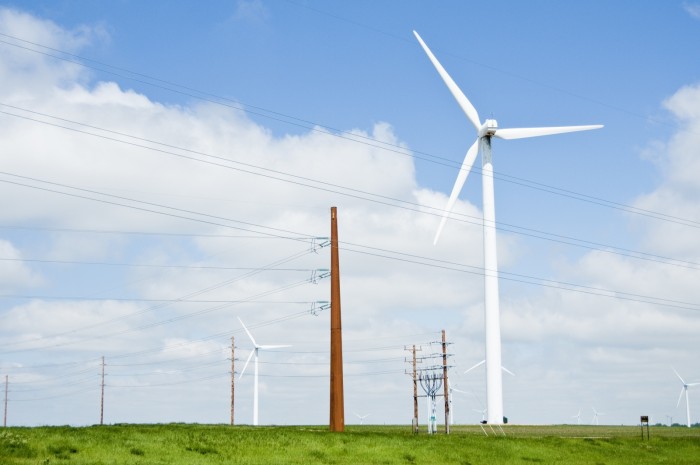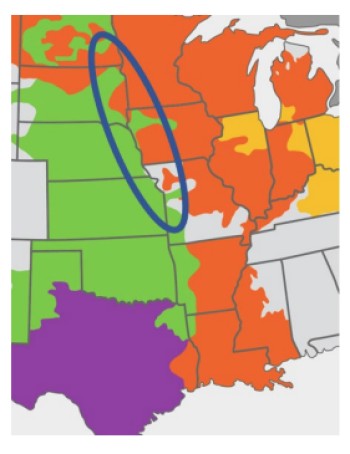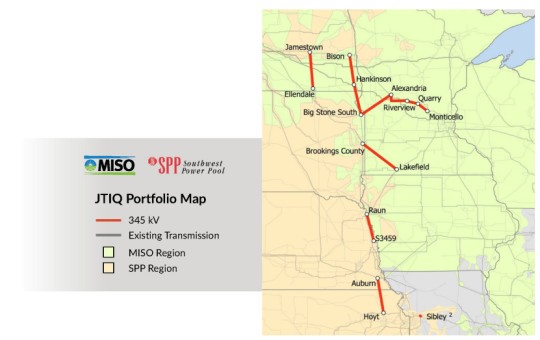MISO, SPP Study Identifies 7 Transmission Lines Enabling 28+GW of New Renewables
 | Kelley Welf, Communications Director |
 turbines and transmission lines
turbines and transmission lines | Kelley Welf, Communications Director |
"Go West, young man!" This phrase referring to the pioneering days of this country implied that the West was a land of opportunity. In the Midwest, the western part of the Midcontinent Independent System Operator (MISO) territory is rich with renewable energy resources, but interconnecting new renewable generation to the grid there has been stymied by a lack of transmission capacity.
As Natalie McIntire, CGA's technical consultant on MISO interconnection matters can attest, interconnecting new clean generators to the grid, "can be a challenging process." Studies are required to ensure that the grid remains reliable with the addition of the new power generating sources, and those studies often take years to complete. In many cases, new generators are required to pay for new transmission lines, substations, or other infrastructure in order to ensure a reliable interconnection. What can make this even more challenging? Trying to connect a generator in one transmission owner's service territory next to a neighboring transmission owner's territory. In that case, there's double the trouble. The new generator needs to be studied by both regions, and may be required to fund additions to both grids, significantly increasing the cost and the time to get projects online.
New wind and solar generation in the northwestern states of MISO have been facing increasing challenges with interconnections for quite some time. In fact, CGA wrote about this issue over 2 years ago (Clarion Call!). It is still a concern because in many cases developers find their projects are no longer viable after their host RTO (MISO), as well as neighboring RTO, the Southwest Power Pool (SPP), require costly upgrades. As a result, many generation developers have had to leave financial incentives and signed Power Purchase Agreements on the table and have said, "The West is closed to new generation!"
Fortunately, MISO and SPP heard this complaint and came together to come up with a creative, collaborative effort to address the problem. In 2020, they kicked off a study that would seek to identify more comprehensive, cost effective transmission solutions to meet the needs of interconnecting generators while providing economic and reliability benefits to load in both SPP and MISO. Thus, the Joint Targeted Interconnection Queue study (JTIQ) was born. The final report is hot off the press.


JTIQ Study Reveals 7 Transmission Projects that can Open the Door for 28GW+ Renewables
JTIQ took the long view when looking for transmission solutions. It did not just consider the new generators that might come on in the next year or two, but instead modeled the expected new generation over a multiple year period, likely representing the next 5 to 10 years. This approach helps to identify more cost-effective solutions, as one larger solution can often cost less than multiple band-aid solutions. MISO and SPP each modeled significant amounts of new generation near their boundary, considered a number of alternative solutions, including those submitted by stakeholders. The results show seven transmission projects in both service territories. The current analysis indicates at least 28GW or more of new generation could be supported while bringing a significant amount of economic and reliability benefits to consumers.
Subscribe to our newsletter for the latest on energy & our work

Next Up: Allocating Costs
Now that the solutions are identified, the real hard part begins. The two regions and their stakeholders need to work through the contentious task of figuring out how to assign the costs of these lines. After all, this is the root of the entire problem. The Federal Energy Regulatory Commission (FERC) requires that costs be assigned in a manner that is "roughly commensurate" with the benefits the parties are expected to receive. In order to do this, more analysis will be needed to better estimate the amount of new generation that will be supported by these lines, and the amount of benefits both generators and load are expected to receive. So far, MISO and SPP have only estimated the benefits load will receive from reduced energy production costs.
In addition to this study work, MISO and SPP also collaborated to implement some welcome changes to their interconnection processes that should result in shorter timelines and more certainty for new generators seeking to connect to the grid.
Clean Grid Alliance applauds this collaborative effort and will continue engaging with MISO, SPP, and other stakeholders, to pursue the next steps necessary to move these lines beyond the study report and toward construction. We look forward to the time when we can re-open the Western part of the MISO footprint to renewable energy generation once again.